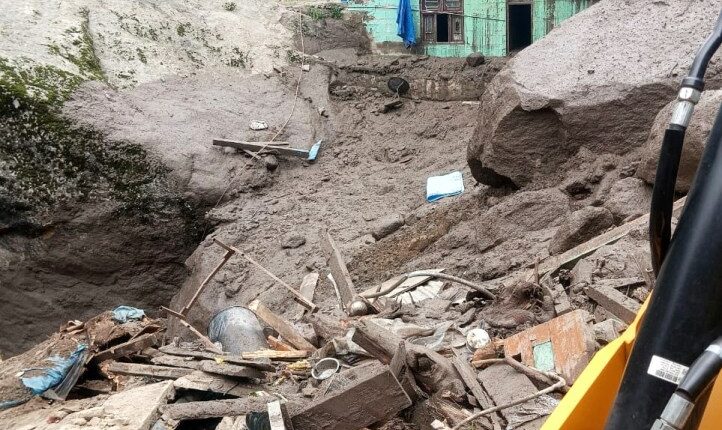Share this @internewscast.com
At least 56 individuals have lost their lives, and many others are unaccounted for after sudden floods swept through a secluded Himalayan village in Indian-administered Kashmir.
Authorities reported that intense, heavy rain initiated the calamity in Chasoti, Jammu and Kashmir, which serves as the furthest point accessible by vehicle on the well-traveled path to the Machail Mata temple.
The floods occurred around 11:30 AM local time on Thursday, ravaging the main dining facility where over 200 devotees were having lunch, along with damaging a security station and several vehicles.
“A large number of pilgrims had gathered for lunch and they were washed away,” one official told Reuters.
Initial estimates suggest at least 80 people remain missing, with more feared trapped under debris, Sky News reports.
Rescue teams have brought around 200 people to safety, but at least 50 of them are badly injured and receiving treatment in local hospitals.
“Army and air force units have been mobilized. Search and rescue operations are in progress,” stated Ramesh Kumar, the divisional commissioner of the Kishtwar district.
Local resident Abdul Majeed Bichoo, 75, said he saw the bodies of eight people being pulled from the mud.
Chasoti, he said, had become a “sight of complete devastation from all sides.”
He added: “It was heartbreaking and an unbearable sight. I have not seen this kind of destruction of life and property in my life.”
Footage showed terrified pilgrims wading through rising water as it surged through the village.
The pilgrimage, which began in July and was due to end on 5 September, has now been suspended.
Jitendra Singh, India’s deputy minister of science and technology, confirmed that a cloudburst, an intense rainfall exceeding 100mm within an hour, was the cause of the floods—an incident becoming more frequent in the Himalayan region.
On platform X, Omar Abdullah, the chief minister of Jammu and Kashmir, remarked, “The news is grim and obtaining confirmed information from the cloudburst-affected area is slow.”
Prime Minister Narendra Modi said “the situation is being monitored closely” and offered his prayers to “all those affected by the cloudburst and flooding.”
The tragedy comes just over a week after a similar deluge wiped out an entire village in India’s Uttarakhand state.
Meanwhile in China, record-breaking floods have killed at least 38 people and forced more than 80,000 from their homes.
Torrential downpours battered swathes of northern China late July, including the capital Beijing, in what locals described as a “once in a hundred years” deluge.
Dramatic footage showed streets transformed into raging rivers, murky floodwater swallowing homes, cars and highways, and uprooted trees piled high in devastated towns.
Beijing’s Miyun district, northeast of the city centre, was the worst-hit, with spillways at the Miyun Reservoir roaring at their highest levels since its construction in 1959.
Nearby Huairou and Fangshan districts were also inundated, while more than 130 villages have lost power.
In the neighbouring city of Tianjin, over 10,000 people were evacuated, and in Hebei province a landslide killed eight people in a village near Chengde, with four still missing.
On social media, residents posted anxious messages about being unable to contact loved ones in the mountainous Xinglong county.
Chinese President Xi Jinping has urged officials to prepare for “worst-case scenarios” and speed up the relocation of residents in danger zones.
The government has pledged 350 million yuan (£42m) for disaster relief in nine affected regions, plus a separate 200 million yuan for Beijing alone.

























